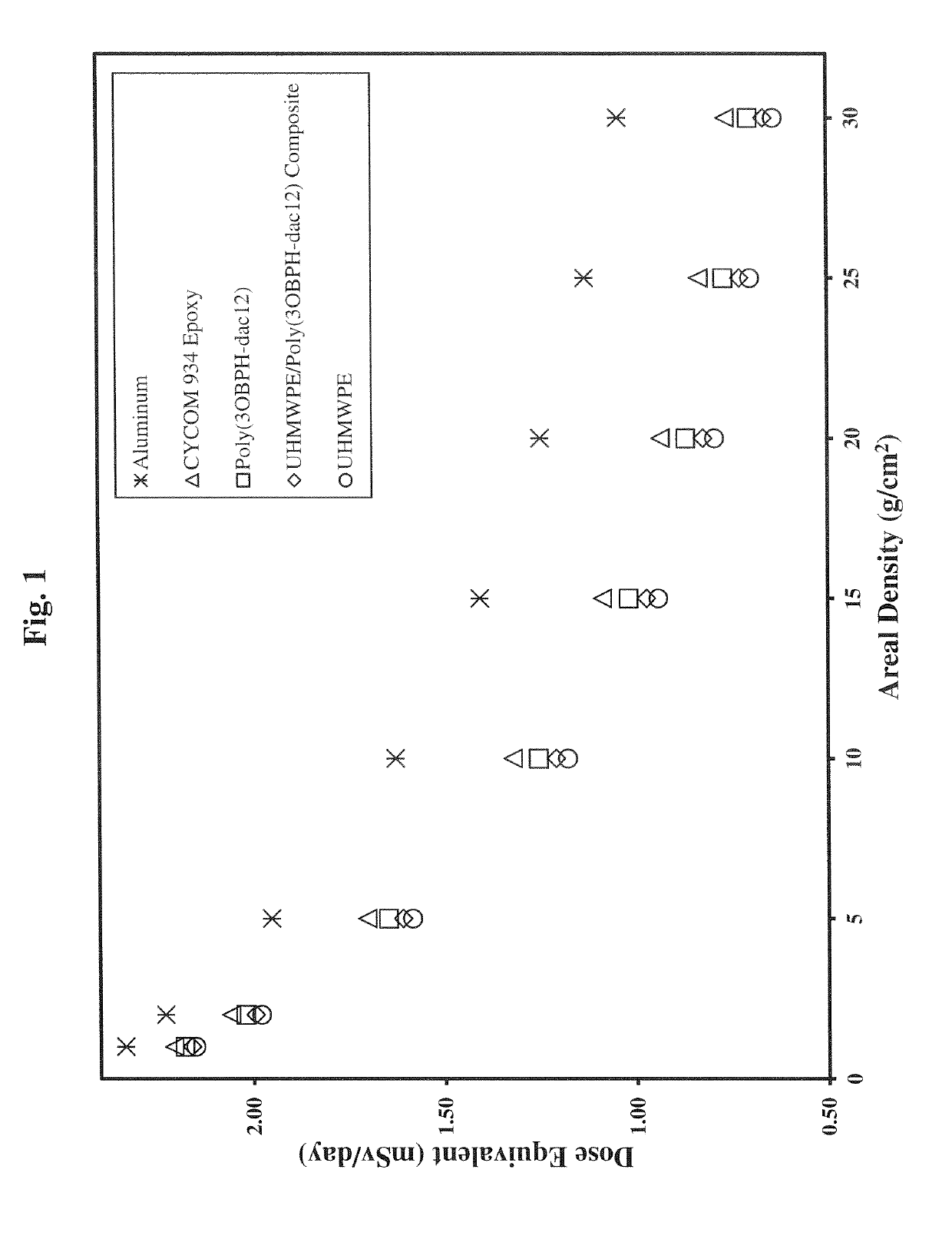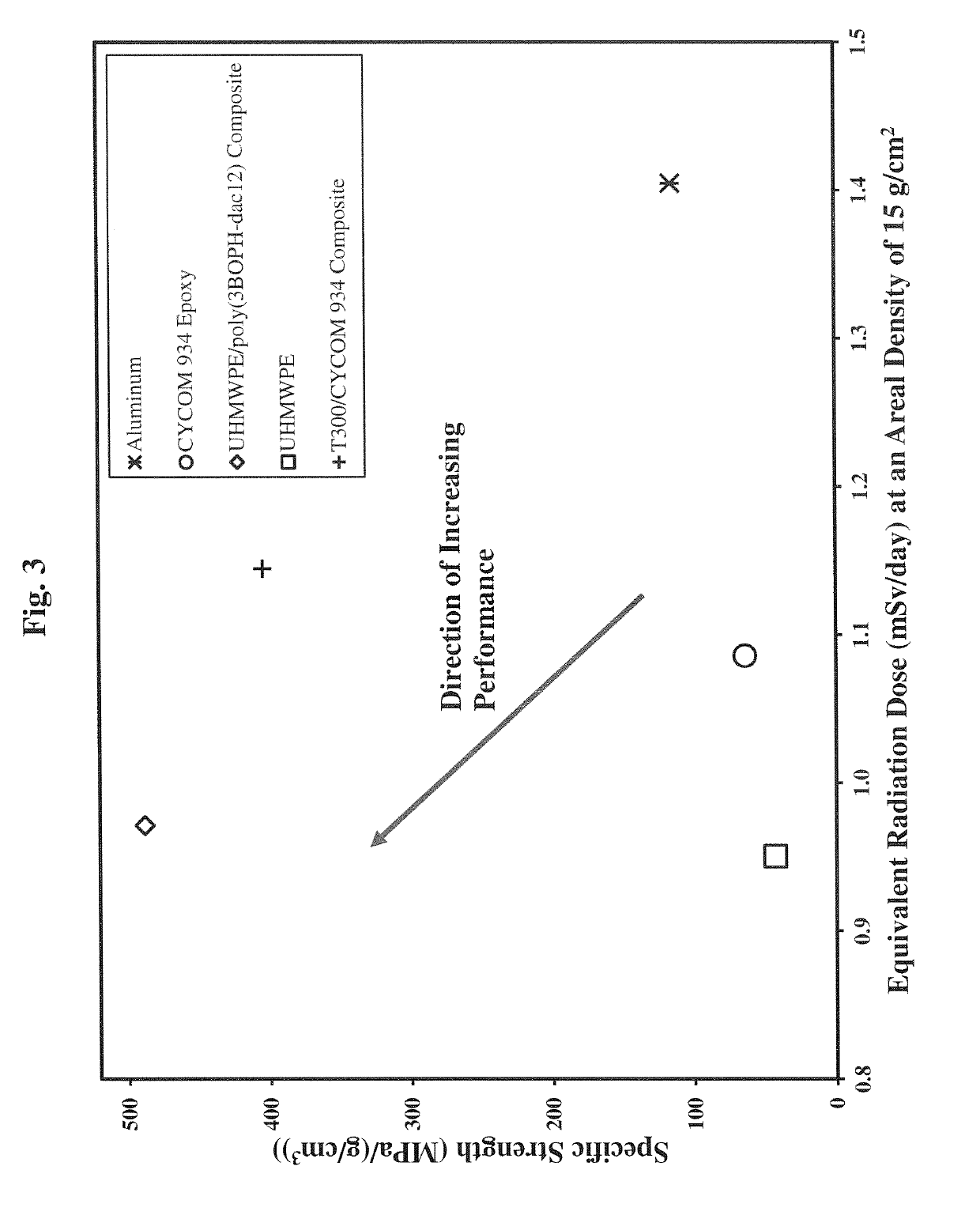Polybenzoxazine resins with high hydrogen content, and composites therefrom
a technology of polybenzoxazine and resin, which is applied in the field of polymer compositions, can solve the problems that existing alternative materials cannot achieve the combination of properties, and achieve the effect of high hydrogen content, adequate shelf life and high hydrogen conten
- Summary
- Abstract
- Description
- Claims
- Application Information
AI Technical Summary
Benefits of technology
Problems solved by technology
Method used
Image
Examples
example 1
of 3OBPH-dac12 Benzoxazine
[0074]3OBPH-dac12 resin monomer was synthesized using the following procedure. 3-Butoxyphenol (3.32 grams), 1,12-diaminododecane (2.00 grams), and paraformaldehyde (1.26 grams) were added to 50 mL of chloroform in a 100 mL round bottom flask. The solution was slowly heated to 60° C. and stirred for 7 hours to promote reaction; the solvent was refluxed continuously. The solution was first washed three times with 1 normal NaOH(aq) solution (50 mL) and then washed with water (50 mL) three times. The resulting solution was dried under vacuum to obtain 3OBPH-dac12, a yellow-brown waxy liquid (4.52 grams). The resulting product was stored in a freezer at approximately −18° C. The resin was cured by different means, including the means described in examples that follow. The isomer content was evaluated using proton nuclear magnetic resonance spectroscopy (1H NMR) and found to be about 75% of 7-substitution and 25% of 5-substitution. The shear viscosity of the resi...
example 2
3OBPH-dac12
[0075]This example describes the cure of approximately 10 grams of neat resin prepared by the method of Example 1. Neat 3OBPH-dac12 resin was removed from a storage jar and added to a silicone mold using a spatula. The mold opening was covered with a lid containing a small vent hole. The mold was placed in a vacuum oven preheated to 60° C. A vacuum of approximately 760 mm of mercury (Hg) was applied and held during the entire cure cycle. The mold was heated at 60° C. for one hour. Oven temperature was then slowly increased to 120° C. over a period of one hour. The temperature was held at 120° C. for two hours. The mold was removed from the oven and allowed to cool at room temperature. The molded part was removed from the mold and found to be a solid polymer, translucent yellow in color, with a density of approximately 1.08 g / cm3. Curing of the resin by opening of the oxazine ring was confirmed using infrared spectroscopy.
example 3
3OBPH-dac12 with Catalyst
[0076]This example describes the preparation and cure of approximately 10 grams of catalyst-modified resin. First, approximately 26 grams of acetone was added to an Erlenmeyer flask. 0.07 grams of lithium iodide (LiI) was added to the acetone and mixed until fully dissolved. Approximately 10 grams of neat 3OBPH-dac12 benzoxazine resin was placed into a separate flask. Approximately 40 grams of chloroform was then added to the flask containing the resin. The resin and chloroform solution was mixed vigorously using a magnetic stirring bar for approximately 10 minutes until there were no visible solid particles of resin remaining.
[0077]The solution of acetone and LiI was then added to the flask containing the resin and chloroform solution. The resulting solution was mixed vigorously using a magnetic stirring bar for approximately 5 minutes. The solution was poured into a shallow tray and allowed to sit under a fume hood at room temperature for one hour to allow...
PUM
| Property | Measurement | Unit |
|---|---|---|
| temperature | aaaaa | aaaaa |
| temperature | aaaaa | aaaaa |
| temperature | aaaaa | aaaaa |
Abstract
Description
Claims
Application Information
 Login to view more
Login to view more - R&D Engineer
- R&D Manager
- IP Professional
- Industry Leading Data Capabilities
- Powerful AI technology
- Patent DNA Extraction
Browse by: Latest US Patents, China's latest patents, Technical Efficacy Thesaurus, Application Domain, Technology Topic.
© 2024 PatSnap. All rights reserved.Legal|Privacy policy|Modern Slavery Act Transparency Statement|Sitemap



